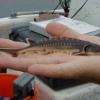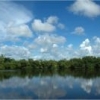Posted 25 July 2017 - 09:05 PM
If I could find some clam shrimp in vernal pools, that would be amazing. I'm not sure what it is about vernal pools, but I absolutely love them. If clam shrimp are here, I would absolutely love to find them someday.
Everything I have found in a vernal pool I have found a use for. And I have sampled hundreds of vernal pools...
One type of vernal pool that many people don't think about is roadside ditches and drainage retention ponds. If you exclude those, I have sampled a few hundred vernal pools all across the country. If you include them, I have sampled a few thousand. Before I joined the army, I used to go searching for drainage ditches full of water and see what I could find, all the time. For years. I would often go out on a weekend and spend the whole weekend sampling drainage ditches. I always found it remarkable how one drainage ditch would have an entirely different set of organisms from one just a few hundred meters up the road. I would take samples home and use my trustee old American Optics 150 microscope and see what was living in it. Never did see a waterbear...
I used to want to write a book about all the stuff I was learning about and finding in those ditches. I was going to title it "Ditch Biology", targeted to kids. Kind of a play on words, since I learned more about ecology and biology from sampling those roadside ditches(and subsequently looking everything up in the library or online) than I ever learned in school. In my mind, if people are really interested in ecology or biology, they could start learning about it in the same way I did. By just getting out there and seeing what they find. At best, they would know if it's a field they really want to go into before they have to make that choice. At worst, they would learn a little about the world around them.
Anyway, moontanman, shoot me a PM and I will tell you where I collected the clams. If you know of any institution that would like such information, I'm all ears. Im happy to report what i find to anyone who may be interested. If i stay in the army until I retire, my hobby is going to be sampling every source of water within reach to find out what lives where. It's actually already my hobby... with what limited time I have at home, I have gotten pretty efficient at selecting sites to sample, depending on what I am looking for. Takes me about 10 minutes to select a site. Takes me hours to really explore it though...
"The ecologist is continually having to look at the aspects of nature with which he is unfamiliar and perforce must be an amateur for much of his working time.... professionals may carp at omissions, misconstructions, or even downright errors in these pages. perhaps ultimately they may forgive them for the sake of the overall vision that only the amateur, or the ecologist, blithely sets out to experience."G. Evelyn Hutchinson










